| Pages:
1
2 |
semiconductive
Hazard to Others
  
Posts: 287
Registered: 12-2-2017
Location: Scappoose Oregon, USA.
Member Is Offline
Mood: Explorative
|
|
The chemical's I'm using are industrial grade. The CuSO4.5H2O root killer states 99% pure. The Stump burner, from past experience, is high in excess
potassium. Perhaps potassium oxide or hydroxide.
I could recrystallize both of the chemicals before running the experiment again, but I wanted to see what would happen with store bought local &
easy to get.
I would think that iron as a potential impurity is likely in the copper-sulfate.
|
|
|
semiconductive
Hazard to Others
  
Posts: 287
Registered: 12-2-2017
Location: Scappoose Oregon, USA.
Member Is Offline
Mood: Explorative
|
|
The second attempt:
4g Stump burner (KNO3)
5g root killer (CuSO4.5H2O)
+5g of H2O, +2g of Isopropyl alcohol ( 500mL water left vs. 200g alcohol in original post. )
I am attempting to crudely mimmic original formulation's final ratio of water to alcohol to see if reaction would proceed and both dissolve and
precipitate slowly. eg: If I warm and cool the solution, I expect solubilities would change and allow reaction to proceed step-wise. The object was
to avoid boiling or raising temperatures significantly above 40C.
I did NOT pre-mix chemicals with water or alcohol, but instead purposely added clumps of crystals so I could ascertain which chemicals had been used
up, and hopefully this would slow down the reaction.
Upon warming the mixture, a surprise happened. The solution immediately began to fizz slightly and separated into two layers. Presumably, the top
layer is isopropyl alcohol and the bottom layer (bright yellow) is an unknown hydration or perhaps double salt ?
I immediately added vinyl electrical tape to attempt to slow down the loss of gas. It held the stopper.
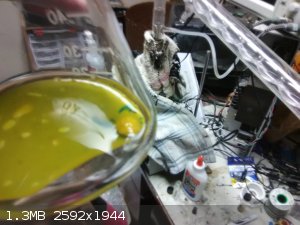 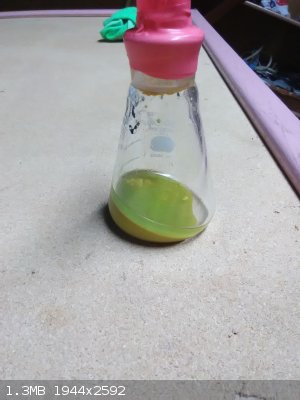
Once I realized heating would cause problems, then I tried shaking in a vibrator instead. That also caused it to fizz and stretch the vinyl tape
(bad odor); so I stopped and let it set on a counter at about 8:30PM. By 9:30PM the solution had separated into three layers: A bottom layer of
yellow, a middle layer of green (probably Cu[NO3]2.??H2O), and a clear layer of liquid on top. After an hour, the green layer had grown in thickness
... so it appeared the reaction was proceeeding toward Cu-Nitrate. Noticably, the blue CuSO4 crystals were on the bottom of the flask, while the
while KNO3 crystals floated to the top of even the greenish layer of fluid. The KNO3 crystals were discolored extra orange on their surfaces. Small
bubbles were also slowly being released from the yellow solution below.
So, the NO3 gas appears to form in the posassium nitrate crystals and make them buoyant; and also in the yellow sludge.
In any event, the final outcome this morning was surprising again. The green layer had completely disappeared and only pure yellow was on bottom with
a clear layer of ?alcohol? on top.
I moved the solution back and forth, and could still see bluish-green copper sulfate crystals. Some very small potassium nitrate crystals are still
attempting to float on the yellow solution.
After shaking the soltuion, some bluish-green fluid formed -- presumably dissolving of more copper sulfate crystals; but it's hard to tell because
even the copper sulfate crystals look more greenish now -- as if they lost water of crystalization.
I'm wondering if the water I added simply isn't enough because the Cu(NO3)2 requires more water of hydration than I allowed for and it is dehydrating
as the reaction proceeds.
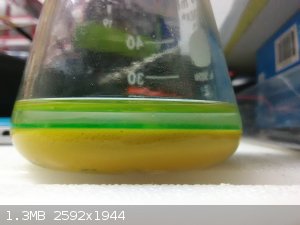 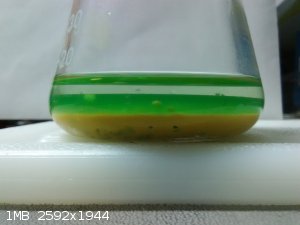
[Edited on 26-1-2018 by semiconductive]
Note: After removing the tape, the flask decrompressed a little. It's been in the dark overnight, but under light and with loss of presure the yellow
sludge is rapidly getting a brown hue on top, under the greenish copper solution I noted before.
[Edited on 26-1-2018 by semiconductive]
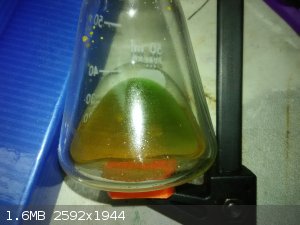
|
|
|
clearly_not_atara
International Hazard
    
Posts: 2694
Registered: 3-11-2013
Member Is Offline
Mood: Big
|
|
More importantly, barium nitrate is not sold as a fertilizer for less than ten bucks a kilo. Using potassium nitrate for this is amazingly wasteful,
in money, time, and nitrate.
[Edited on 04-20-1969 by clearly_not_atara]
|
|
|
semiconductive
Hazard to Others
  
Posts: 287
Registered: 12-2-2017
Location: Scappoose Oregon, USA.
Member Is Offline
Mood: Explorative
|
|
Quote: Originally posted by clearly_not_atara  |
More importantly, barium nitrate is not sold as a fertilizer for less than ten bucks a kilo. Using potassium nitrate for this is amazingly wasteful,
in money, time, and nitrate. |
True: Unless you live on a farm with horses and can get potassium nitrate for free, like me. Also, how much urine does a human make a day? If left
to ferment in the right container with potassium containing ashes for a year ... guess what you get? Free KNO3.
I'm actually doing this to learn about chemistry, just for the sake of knowledge. I don't think that's a waste. By working my way through problems,
and what does and does not go wrong ... I'm hoping to learn about colors of ions in solution, and get some practice working out mass action laws; etc.
This experiment potentially gives me two chemicals, both of which I happen to want for a different experiment; K2SO4, and Cu(NO3)2
Besides, can you tell me why the sludge is yellow ... that's pretty interesting given the normal colors of copper compounds.
|
|
|
clearly_not_atara
International Hazard
    
Posts: 2694
Registered: 3-11-2013
Member Is Offline
Mood: Big
|
|
You oxidized the isopropanol, reducing some nitrate present to nitrite. Copper nitrite forms a yellow-orange complex:
http://www.sciencemadness.org/talk/viewthread.php?tid=29805
The "sludge" could be explained by some copper-nitrite complex migrating into a phase which also contains polymers of acetone.
[Edited on 26-1-2018 by clearly_not_atara]
[Edited on 04-20-1969 by clearly_not_atara]
|
|
|
semiconductive
Hazard to Others
  
Posts: 287
Registered: 12-2-2017
Location: Scappoose Oregon, USA.
Member Is Offline
Mood: Explorative
|
|
You might want to re-read that thread. Mixing nitrate ions with copper produced a green color in the first post, and the article referenced in the
last post says it goes between Green and Purple at around room temperature.
It's Lead and nitrite which both poster's agreed produces the yellow-orange color.
There's no lead in my chemicals... I am sure of that much.
I also just checked the math of the original recepie ... and there is definitely enough water in my system to mimmic the recepie. The only water of
crystalization is in excess:
CuSO4.5H2O + K2(NO3)2 --> Cu(NO3)2.3H2O + 2H2O + K2(SO4)
But, you might be right -- it's possible the nitrate is oxidizing the alcohol. That would also be an issue with the original recepie.
SInce the main problem I've observed is loosing NO2 or NO3 as gas during the reaction, I'm going to try again using ammonia water to make the PH basic
so that nitrate doesn't want to leave the solution.
After the reaction finishes, I'll evaporate the ammonia off (or maybe vacuum dessicate) at low temperatures. We'll see if I still get yellow-orange
complex in that case.
[Edited on 27-1-2018 by semiconductive]
|
|
|
semiconductive
Hazard to Others
  
Posts: 287
Registered: 12-2-2017
Location: Scappoose Oregon, USA.
Member Is Offline
Mood: Explorative
|
|
Please excuse the first sentence of the last post, I meant "nitrite" not nitrate; they both cause green colored solutions.
EDIT:::: Part of this post was originally an error, and I don't know how to delete it. The stump burner I bought is likely sodium pyrosulfate, which
is a first for me. It wasn't marked on the label, anywhere. So, take this post as an explanation of how I got suspicious because of the solubility
error in what I thought was potassium nitrate.The math is correct, the chemical likely wrong. I have since purchased genuine stump burner with
potassium nitrate in it "spectracide Stump Remover" brand, from Fred Meyers, and will try again. The other stump burner, "stump out" from Ace
Hardware is likely NOT potassium nitrate; though I wasn't able to get an MSDS from the manufacturer several people have complained about it, online
and ace's computer listing says it's pyrosulfate.
---------------------------------------------------------------------------------------------------------
I have done part of the next expermient. I did not expect to get yellow material in solution with ammonia before dessication, but I did get it. That
yellow stuff is a colloidal suspension that turns into a precipitate of micro-crystalline material. Yellow is not a normal copper ligand-ion
interaction color, I'm pretty sure, because it's opaque. I am not sure if it's some kind of double salt, or just the effect of having two different
crystals intermixed at a microscopic level.
However there was another unexepected surprise in the ligand coloration before it became yellow colloidal suspension and then crystals.
During the reaction with ammonia present, a clear red liquid formed. It's dark red, but it looked very transparent and not cloudy for a short period
of time. Therefore, I assume it's a new color caused by some combination of sulfate and ammonia acting as ligands in solution.
I haven't desiccated the solution yet, as I discovered something else on the way. Let me first describe the experiment, the surprises, and show the
photos of the steps.
This time, I used ammonia water from Ace Hardware which is suppsed to be a 10% solution; nothing but ammonia is listed on the bottle or the MSDS that
I saw when I bought the bottle a year ago. It's lost some of it's smelling strength, which means that a certain amount of ammonia worked it's way out
of the cap over the year. It's still pretty strong, though.
In any event, I decided to try and dissolve 4g of -----(stump burner) from ace into ammonia water and then chill it in a freezer before adding 5g of
CuSO4.5H2O crystals. I hoped chilling the dissolved stump burner in ammonia would stop the release of gas that I noticed when I mixed the CuSO4 in
the previous experiment and boiled. Again, the point of this attempt is to mix reagents with insufficient water to completely dissolve either of them,
and see if the reaction can be carried out without having to boil off large amounts of solute afterward.
These are the constants I have looked up from the original recepie for the substances used:
4.04g of KNO3 / 101.1032 g/mol = 0.040 mol (Sol is 316mg/mL @ 20C --> 12.7mL water/4 gram KNO3, 2.46g/mL @ 100C --> 1.6mL water/4 gram KNO3)
4.99g of CuSO4.5H2O / 249.685 g/mol = 0.020 mol (Sol is 320mg/mL @ 20C --> 15.6mL water/5 gram CuSO4.5H2O )
So, the approach I wanted to take was to dissolve KNO3 in boiling ammonia water to bring it to super-saturation, then chill it below room temperature
(10C or so). Ammonia is not a common ion with nitrate, so I decided to measure out enough water to dissolve all the KNO3 just assuming the excess
concentration of ammonia would not affect the nitrate solubility. (But it didn't go as planned, which made me suspicious. )
I measured 2.46mL of water times 110% since ammonia is less dense than water; I hoped that would give a rough starting point for the solubility of
KNO3 in 10% ammonia water. ( 2.7g of ammonia water. ) and the maximum water I wanted would be the amount that could dissolve all the copper nitrate
formed, but not enough to dissolve the potassium sulfate that would be formed.
K2SO4 * 0.02mol * 174.259g/mol = 3.485g ( sol. W 0.11g/mL 20C --> 31.682g H2O )
Cu(NO3)2 * 0.02mol * 241.60g/mol= 4.832g ( sol. W 1.25g/mL 20C --> 3.866g H2O )
I brought 4g of stump burner it to a boil in a capped earlenmeyer flask with 2.7g of ammonia water. If this had been pure water for
re-crystallization, it would have easily dissolved the whole amount at boil. But it did not. So, I kept adding ammonia water and watching the
dissolution until I had enough water to dissolve all the copper nitrate in the final solution (which was not my original goal.) I ought to have
stopped at 3.866g of H2O, but went all the way to 10.63g before quitting. Even then, the KNO3 had not all dissolved. Since this was almost 4x the
ammonia water compared to the necessary distilled water, I figured the remaining stump burner had to be impurities; and just removed them. The wet
impurities only ammounted to 100mg of the 4g put in the jar; so it's not critical.
In any event, even though the Erlenmeyer flask was capped with a glass stopper; none the less, I'm sure I lost most of the ammonia. The ability of
strong ammonia in suppressing the solubility of KNO3 was not expected (Edit: because it wasn't KNO3)
I then chilled the solution in a freezer, down to about 10C. Absolutely NO KNO3 precipitate fell out of solution after 15 minutes of chilling.
I measured out 5g of CuSO4.H2O, and added a few crystals to the flask. There was no bubbling, the surface of the blue crystal immediately turned
green, and a greenish diffusion streams could be seen dissolving in the solute. After about a minute, I could see white precipitate start falling out
of solution. I don't know if it's KNO3 or K2SO4. I was satisfied that the solution wouldn't out-gas, so I added all 5 grams of CuSO4. No gassing
happened. after a few seconds, I smelled the solution and there was no odor at all; neither ammonia, nor foul NO2 gas smell. So, this is much better
than the prior experiment; but it makes me think I lost almost all the ammonia.
I capped the flask and clamped it tight, and let the crystals slowly dissolve while I gently swirled the solution once every five minute or so. It
was now warming up toward room temperature. After an hour I smelled the solution to verify that nothing had changed. There were no strong smells all
the way to the completion of the experiment.
The water continued to precipitate white material, and the water itself had a colloidal suspension until approximately half the copper sulfate had
dissolved. Then suddenly, an organgish color could be seen coming off the crystals. Soon this color turned a transparent and very dark red. I did
not monitor the solution for about a half hour, and when I came back; the whole flask was filled with a yellow suspension and the red coloring was
gone. I still couldn't smell ammonia, or nitrate; and since the color was yellow, I decided to add ammonia water (1 gram) to see if the blue color of
copper-ammonia complex would show up before mixing. It did, very dark blue (see photo). Once the solution mixed, though, the blue turned green (the
color of Cu(NO3)2. ) and the yellow suspension fell to the bottom as a micro-crystalline precipitate. Since there was no alcohol, I assume there is
nothing to oxidize to make nitrite and this ought to still be a nitrate compound. Ammonia complex is typically blue, and once dissolved I got green
liquid. I have purchased sodium nitrite in order to repeat the experiment with a pure sodium nitrite for preserving meat; then I can check nitrite
color in an analogous experiment.
I went to bed and when I got up in the morning I noticed that the top surface of the yellow precipitate had turned a brilliant white. The water above
the precipitate was now a darker green. When I turned the light on, after a few seconds, a small amount of black precipitate formed on top of the
white and then stopped. I could see it darken with time over a period of a minute. So, the solution appears to have something which is
photo-sensitive (at least to UV light) and not RED LED night lights in it. After shaking the solution, a few times, no more dark precipitate formed.
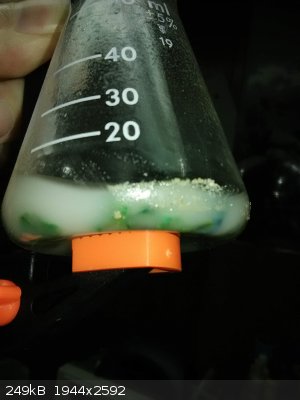 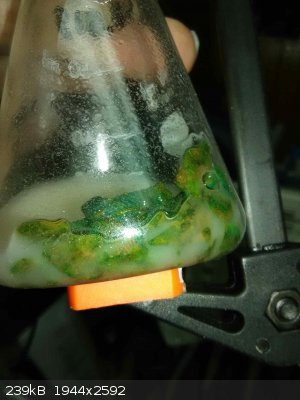 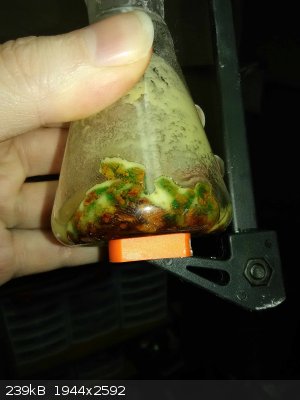 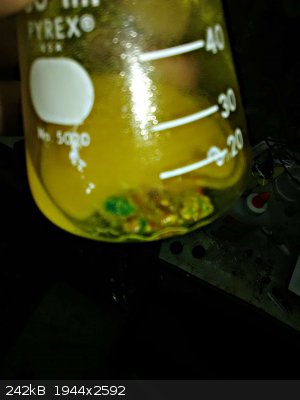 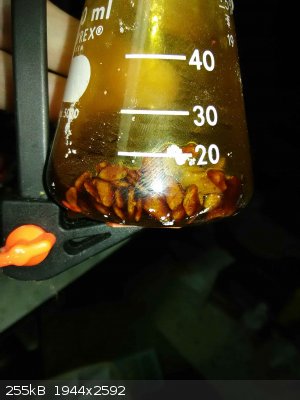 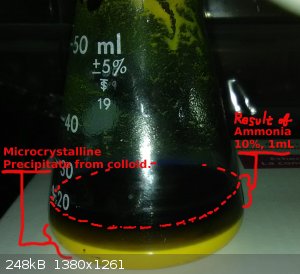 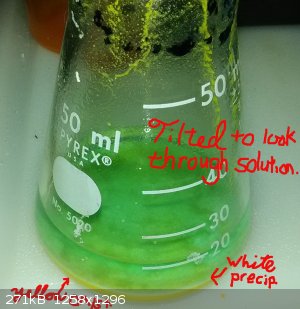
Edit: The precipitate has since turned grey, slowly; while the solution remains green. The number of correspondences between the expected behavior of
the potassium nitrate with copper sulfate, compared to the probable sodium pyrosulfate are astonishing.
[Edited on 30-1-2018 by semiconductive]
|
|
|
semiconductive
Hazard to Others
  
Posts: 287
Registered: 12-2-2017
Location: Scappoose Oregon, USA.
Member Is Offline
Mood: Explorative
|
|
Apparently, the photo-active nature of some Copper salts are well known.
https://www.google.com/patents/US3671249
I've been thinking of using copper (I) or (II) nitrate to attempt to copper glass (rather than silver it). I now notice that the copper salts are
actually far similar to photo-active silver than most people realize.
In this experiemnt (but not the prior one) ammonia was present. So I looked up ammonium nitrite which is going to be present in microscopic amounts.
http://www.sciencemadness.org/smwiki/index.php/Ammonium_nitr...
The color is "pale" yellow, which I don't think matches the color in the flask which is a "bright" solid yellow. But, unfortunately, no one at
science-madness, nor wikipedia, posted a picture of the salt; so it's hard to be sure. However, the yellow color that I have here is the same as in
the previous experiment, where no ammonia was present. So, I think it's likely NOT ammonium nitrite.
[Edited on 30-1-2018 by semiconductive]
|
|
|
semiconductive
Hazard to Others
  
Posts: 287
Registered: 12-2-2017
Location: Scappoose Oregon, USA.
Member Is Offline
Mood: Explorative
|
|
Quote: Originally posted by LearnedAmateur  | Quote: Originally posted by semiconductive  |
This is consistent with later posts claiming that decomposition of copper nitrate produces that smell; and wikipedia stating that decompostiion occurs
at 80C and above. 
|
Well there’s a reason why we shouldn’t trust Wikipedia, I’ve got a completely different set of values. When I redissolve my salts, including
copper nitrate, I always heat to boiling and have had no issue with decomposition below 100C. Maybe there are impurities affecting the stability?
[Edited on 26-1-2018 by LearnedAmateur] |
Yes. There was definitely a big impurity -- I apparently used the wrong reagent. Although what you are telling me is disturbing in another way once
I did the experiment with potassium nitrate. As I mentioned, I'm doing these experiments just to gain experience and learn about the various
chemical reactions.
Since the actual post you commented on, according to Ace hardware, was using disodium sulfate (Sodium pyrosulfate); it ought to have reverted back to
sulfuric acid as it absorbed water. It should also produce sodium hydrogen sulfate. In my reaction it is possible that pyrosulfate released sulfer
tri-oxide as the chocking gas I smelled.
But ... I would not have expected Copper-I-Oxide (Cu-O-Cu) to precipitate, and pure shiny copper to form on the surface of fluid as it boiled. (
There was no air, so it was basically boiling in a vacuum capped flask ). But, that's what I got as a result.
The reaction is a total surprise to me, and I think I may start another thread to examine the reaction if it's not easily explained.
The yellow copper precipitate, according to @woelen , is hydrated copper oxide.
http://woelen.homescience.net/science/chem/solutions/cu.html
But Woelen also says that copper I complexes are unstable/don't exist in aqueous solution.
That begs the question as to what that red complex actually is, since it only exists for a short time when the solution has been cooled -- and it's
transistioning from a copper-sulfate, to a hydrated copper oxide VIA a pyrosulfate... Wouldn't the pyrosulfate be absorbing any molecules of hydration
(temporarily) before the yellow precipitate formed ??
I'll bump woelen, to see if he has any comments.
I now have good potassium nitrate and am trying the original recepie instead of the pyro-sulfate. My results are different from pyrosulfate with
lots of interesting things happening. I've even tried raising the solution to the boiling point because of your anecdote ... but the results I'm
getting suggest that copper II nitrate is not as stable as either basic copper nitrate, or an alcohol substitution of some kind. Getting this
reaction to go to proper completion is not easy.
I suppose the important question is "how fast" does Cu(NO3)2 break down at various temperatures? Wikipedia's data might be the onset occurs, but it
might not be a fast breakdown until much higher temperatures. They don't specify how it was measured... so I don't know how significant their number
is.
Did you do any kind of test on the steam vapors, or weighing the remaining crystal, to make sure there wasn't significantt loss of NO3?
-------------------------------------------------------------------
Edit: See links ... I think you are right in general,: I found some thermal degradation studies and they show breakdown begin around 380Kelvin =
106C according to DTGA analysis.
http://glenchung.bol.ucla.edu/labglen/CuNo32.pdf
There's only one study which lists the breakdown product at lower temperatures... and several of these studies are at reduced pressure; not
atmospheric. ( Table I ).
http://carbonlett.org/Upload/files/CARBONLETT/5(4)-04(E).pdf
[Edited on 2-2-2018 by semiconductive]
|
|
|
semiconductive
Hazard to Others
  
Posts: 287
Registered: 12-2-2017
Location: Scappoose Oregon, USA.
Member Is Offline
Mood: Explorative
|
|
| Quote: | I've completed the second round of experiments. So far, the first two replies in the thread appear to correctly predict the difficulty in getting
CuNO3, even though the second reply is based on incorrect solubility data which is pointed out by a third poster.
Quote: Originally posted by Hexavalent  | Yes, this could be problematic as both copper (II) nitrate and potassium sulfate are soluble in water, quite well.
...
The overall equation is; 2KNO3 + CuSO4 → K2SO4 + Cu(NO3)2, but you will, of course, not just get copper nitrate as the product. What actually
happens is;
2[K+] + 2[NO3-] + [Cu2+] + [SO42-) → 2[K+] + [SO42-) + [Cu2+] + 2[NO3-]
|
Quote: Originally posted by Vargouille  | | I doubt it would work. The solubility for copper sulfate is the lowest, and that of copper nitrate is the highest. Most interestingly, you might be
able to make a double salt, but it won't be simple to purify into either nitrate. |
Versus this post:
Quote: Originally posted by bbartlog  |
No. Potassium sulfate is the least soluble and would precipitate first, especially at high temperatures (e.g, as you boil off water) as its solubility
does not rise as rapidly as that of copper nitrate (or copper sulfate, for that matter) with increasing temperature.
You could proceed as follows:
Dissolve four moles (404g) of KNO3 in a liter of warm water
Dissolve two moles (499g) of CuSO4 (pentahydrate) in a liter of hot water
Mix these, boil off 1500g of water (you would likely need to filter or decant at times to get rid of the precipitating K2SO4, or deal with a lot of
bumping...). Cool to freezing, filter to remove more K2SO4. The remaining liquid should still contain all the copper and nitrate, but less than 40g of
K2SO4 (the remaining 310g of it having precipitated). You could then drive off the remaining water (carefully, so as not to decompose the copper
nitrate) and have ~90% pure Cu(NO<sub>3</sub> <sub>2</sub>
with the remainder as potassium sulfate. Alternatively, adding 200g of absolute ethanol would precipitate 90% of the remaining K2SO4 and you could
then obtain 98-99% pure copper nitrate. <sub>2</sub>
with the remainder as potassium sulfate. Alternatively, adding 200g of absolute ethanol would precipitate 90% of the remaining K2SO4 and you could
then obtain 98-99% pure copper nitrate.
|
The results I explain in this post are definitely done with the correct chemicals. eg: 4g & 5g of K2NO3 and CuSO4.
However, the results are still complicated because of the alcohol. I need to re-test, to make sure the (disputed) breakdown CuNO3 data from Wikipedia
+ an unknown issue with CuNO3/K2SO4 and alcohol aren't ruining results. I also want try adding ammonium sulfate to see if Le chatlier's principle can
be used to change solubility of K2SO4.
My tentative conclusion, is that there is one of the following: decomposition of the nitrate, creation of a double salt with solubility
LOWER than K2SO4 (!!!??), or else interaction (adduct?) of ions with alcohol to change the solubility of a double salt.
I've tried the experiment under isopropyl, ethanol, and methanol; with water limited to the theoretical amount needed to dissolve the CuNO3 product.
Eg: The reaction is carried out with that amount of water, plus the same or more in alcohol stirred vigorously for 24 hours under heat of 75C.
I then transfer the solute to a second container and either distill off the alchohol (75C) or chil the solute to precipitate some of the dissolved
salt; I then repeat the washing of the original precipitate by returning only the distilled or chilled alcohol solution to the original container.
(Without more water in the case of distilled alcohol.) The distill/chill/rewash cycle was repeated ten to twenty times each. In chill cycles, a
bright white precipitate formed in the second flask ... but was indistinguishable from the precipitate in the first flask; as both turn faintly green
when exposed to sufficient water or dried in air. In distill cycles, the remaining water solution that is kept in the second flask turns increasingly
blue.
In all reactions, the alcohol solution is either aqua-marine or clear. Under strong alcohol the precipitate is always white.
When reacting the checmicals under IPA, a very curious effect happened. As temperature is raised from 70 to 80C all the colored solution precipitates.
The precipitation is so rapid (1-2 seconds) that I believe it's very sensitive to an exact temperature. I don't trust my thermometer to measure the
actual temp within 1C, so am not reporting the threshold. But adding either ethanol or methanol will cause the hot precipitate to re-dissolve and the
sensitivity to temperature is canceled.
Re-running the experiment under ethanol-water or methanol-water does not have the negative solubility issue.
The precipitate formed under alcohol solutions is always white. However, almost all the copper is in the white precipitate. Letting water get to the
precipitate turns it faintly green, and ammonia water turns dark purple, no matter how many washings are done.
Repeatedly washing the first precipitate in re-distilled methanol is the ONLY way that I was able to produce a concentrated and beautiful blue
solution in the second flask. But the solubility of copper nitrate is much smaller than expected and re-distilling is impractical for producing
CuNO3; even after 10 cycles only a tiny amount of CuNO3 is isolated.
Returning our attention to the initial precipitate in the first flask. As a final check ... I re-dissolved ALL of the initial precipitate in 500mL of
water. It turned light blue. I then evaporated off around 100mL of water at 90C using air to speed up the evaporation. Surprisingly the vast
majority of precipitate to fell out of hot 90C solution a second time with 400mL!! of water still present. The color of the water solution is blue,
but the precipitate is light green. This extremely low solubility and color of precipitate is a big surprise. I wonder if there is some kind of
alcohol ?adduct? that can survive re-dissolution and precipitation under water.
Wikipedia's dubious/ambiguous alcohol vs. water solubility data is a severe complicating factor. I am not certain which alcohol they are referring
to, and if alcohol can chemically react with the nitrate or sulfate ions sufficiently to disrupt the experiment.
[Edited on 11-2-2018 by semiconductive] |
|
|
|
semiconductive
Hazard to Others
  
Posts: 287
Registered: 12-2-2017
Location: Scappoose Oregon, USA.
Member Is Offline
Mood: Explorative
|
|
Summary of quantitative results of Cu2NO3 preperation via alcohol-water route and multi-distillation.
Using 4g K2NO3, 5g CuSO4, and 3.87g of water with a small amount of ammonia, and 4g of alcohol; eg: making a ~50% solution; I evaporated the
remaining water at 90C. There are obviously some impurites left, but the crystal still looks decent. A small odor came off while drying at 98C which
was not ammonia smell; I don't know if I lost a small amount of nitrate, ammonia, alcohol, or a combination. It wasn't very strong, so I don't think
I lost much mass. I end up with 0.888 grams of dark blue crystal.
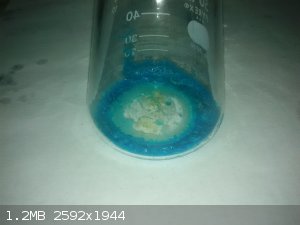
The theoretical yield should be:
K2SO4 * 0.02mol * 174.259g/mol = 3.485g ( sol. W 0.11g/mL 20C --> 31.682g H2O )
Cu(NO3)2 * 0.02mol * 241.60g/mol= 4.832g ( sol. W 1.25g/mL 20C --> 3.866g H2O )
So I ended up with: 0.888/4.832 = 18% yield even after many distillations to increase effective solvent used (like a soxhelet extractor, but done
manually ... sigh.)
After re-dissolving the bulk of the precipitate in 500mL water (excluding the blue stuff in the picture above), a large amount of the re-dissolved
crystal re-precipitated by the time I got to 400mL of water. I removed that precipitate and set it aside. The remaining 400mL of solution was
evaporated to dryness at 90C.
Three layers of crystal formed. First a greenish color on bottom, then a green-whitish color, then a deep blue layer.
Because of the large amount of water, the alcohol should have been long boiled off before evaporation completed. The fact that I got blue
precipitate on top made me suspicious that there is a water-alcohol double salt/adduct that is more soluble than copper nitrate in alcohol.
Since there should be absolutely no water in the remaining precipitate, I tried adding straight methanol to it as a test. Sure enough, only the blue
crystals dissolved into methanol. Photo, below. The color of the alcohol is blue and not aqua-marine. This bolsters my suspicion that a large part
of this last process's problems were because of using both water and alcohol at the same time. Apparently the alcohol can somehow react/adduct with
postassium sulfate and copper nitrate when water / water of crystallization is present.
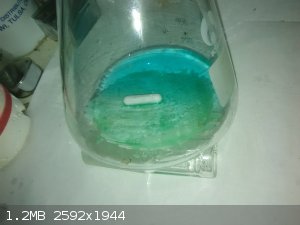
[Edited on 14-2-2018 by semiconductive]
[Edited on 14-2-2018 by semiconductive]
|
|
|
Omniquist
Harmless

Posts: 10
Registered: 8-2-2018
Member Is Offline
Mood: No Mood
|
|
I apologize if this post is off topic. I've just sat here reading this thread and the pretty picture thread so some of this (if not all) may seem
scattered...This reminds me of some experiments I'd done with root killer grade cuso4, which upon recrystallizing has proven to be very pure indeed.
I'll post my monocrystal when I figure out where it is so I can take pic. It's a rhomboid three inches long at least at its longest and about just
under two at perpendicular angle, at widest. Someone above said they don't have calcium nitrate and that's what got me to post. I was on a mission to
produce nitric acid without any sulfate salts in it, without a distillation possible until I make or somehow find to buy one. I had kno3 and plumber
grade h2so4. I made diluted solution of nitric with these two things, the kno3 and sulfuric with some copper wire, a method nurdrage mentioned using
hcl, but I found sulfuric was far superior to hcl at producing no2 gas and in short time. I, one by one, dissolved some berry flavored tums tablets
into this nitric solution and in short time had some calcium nitrate foam with echoes of berry flavoring the air. It took a long time to evaporate and
at the time I couldn't find a hot plate, even at lowes and Walgreens, where in the other state I lived one could find for very cheap, like 13 dollars
(I paid more for a used one on eBay, but it had the magnetic stirrer atleast, unlike the one I have now, which I ended up getting at a camping store.
Anyways, immediately upon adding to the pinkish calcium nitrate (color was due to tums' tablet dyes) the sulfuric acid no2 was driven off with
abundance and upon filtering (thru a lava rock filter I made in honor of the Buchner funnel) a pretty strong solution of clear nitric acid was
obtained, the calcium sulfate that was created was trapped in the filter. So if you can make a weak solution of nitric acid, then you can have calcium
nitrate in pretty pure form. Thanks for wisdom and time everyone.
|
|
|
Omniquist
Harmless

Posts: 10
Registered: 8-2-2018
Member Is Offline
Mood: No Mood
|
|
Oh, to the guy above who posted the pics of the pretty copper salts. If you want to purify and find out what it is, see if you can pull some mono
crystals off. They are either a rhomboid or something not rhomboid. I believe nitrates form needle-like crystals. Tie a string to the little
monocrystal and submerge this crystal in a saturated solution of your mystery salt(s). Nice pics. Here's my cuso4*5h20 monocrystal.
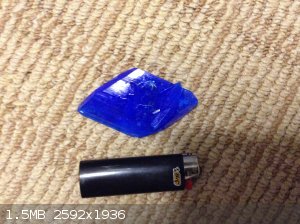 I forgot, that's one of the full size bic lighters, so three inches was modesty. I forgot, that's one of the full size bic lighters, so three inches was modesty.
[Edited on 16-2-2018 by Omniquist]
[Edited on 16-2-2018 by Omniquist]
|
|
|
Omniquist
Harmless

Posts: 10
Registered: 8-2-2018
Member Is Offline
Mood: No Mood
|
|
Hanging out in the library and I saw this in a book on organic chem.. Looks like there's a possibility that you could do the nitrate salt and sulphate
salt swap, but it would seem adding a current of so2 gas catalyzes the reaction to completion. However, this is for the chloride, so this could be
irrelevant. I just took a screen shot so....here, hope this helps.
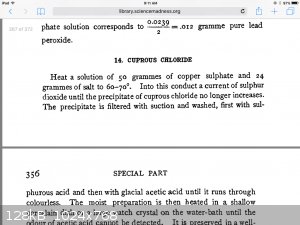
|
|
|
semiconductive
Hazard to Others
  
Posts: 287
Registered: 12-2-2017
Location: Scappoose Oregon, USA.
Member Is Offline
Mood: Explorative
|
|
Partial Quantitative success: Water only method produces Cu(NO3)2 From KNO3 and CuSO4.5H2O
I've been running the experiment in several variations. I've had some successes, now. The third poster who said Cu(NO3)2 could be produced is
correct. Impure Copper Nitrate CAN be produced from solutions in water with evaporation at 65C.
I will report the results from crude (non-recrystallized) starting reagents first. This is most likely what other amateurs would try for a quick
test; and this post is dedicated to that set-up.
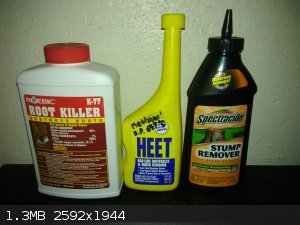
I dissolved 4g KNO3 ( Spectracide brand stump burner) in 25mL hot R.O. water.
I dissolved 5g CuSO4.5H20 ( Roebic (tm) K-77 brand ROOT KILLER ) in 25mL R.O. water.
There is up to 1% impurity in root killer, and spectracide stump remover is expected to be contaminated with excess potassium oxide, hydroxide, and
carbonate from air. I tested root killer sample. Dehydrating 5g on dull red burner yields: 3.180g. Some black carbon was formed. Theoretically
dehydration should yield ~3.2g ; therefore 20mg error/5g ~= 0.4% impurity + excess water. This should not affect final yields by much.
I combined the two solutions and placed on a magnetic stirrer at 65C in a 50mL Erlenmeyer flask. I placed silicone tubing above the liquid and
attached tubing to an aquarium pump. Gentle air blowing evaporated the warm water fairly quickly (hours vs. days unaided).
After evaporating 25mL of solution, a greenish-opaque crystalline mass formed. I transferred all liquid to another flask, and weighed the crystalline
mass with tare weight of flask. I dried the crystalline mass for an hour before weighing.
--------------------------
Result I: Evaporating 25mL solution produces 0.520g of light green crystalline mass.
~0mg of first crystalline mass is soluble in methanol.
--------------------------
I used methanol to test alcohol solubility (HEET, Yellow bottle with blue writing for car gas dryer is methanol, Don't use ISO-HEET, that's
Iso-propyl.).
CuSO4 and K2SO4 are insoluble in methanol, but CuNO3 with water of crystalization is very soluble. No mass loss was detected. Greenish precipitate
must be some kind of double salt of copper/copper hydroxide and potassium?
I then re-dried the crystalline mass for 20 minutes. (Edit: Fixed a typo in earlier post).
I re-placed the remaining solution back on stirrer in new erlenmeyer flask. I evaporated off more liquid. Again a greenish crystalline mass formed
... but this time it was far more translucent and lighter green.
-------------
Result II: evaporating additional ~12mL of water produced 0.956g of crystalline mass.
26mg of crystal was soluble in methanol.
-------------
Therefore, some Cu(NO3)2 was likely in the second crystalline mass.
I again evaporated more liquid in a clean, tared flask. As distinct blue crystals began forming when around ~6mL of solution was left, I decided to
add just enough R.O. water to redissolve them; and then poured off the remaining solution into a clean flask. Then I weighed the remaining greenish
crystalline mass.
--------------
Result III -- 1.504g of greenish crystalline mass from ~6mL of evaporation.
methanol solubility was not tested.
--------------
I collected all the crystalline green mass from all the evaporation cycles. I attempted to redissolve the crystalline mass in 50mL of R.O. water with
vigorous stirring. The crystalline mass only partially re-dissolved. A concentrated powdery green precipitate remained on bottom of the flask.
Heating and prolonged stirring did not change the result. The Greenish copper salt that precipitates is almost entirely insoluble in water. The
translucent part does redissolve. I assume that the translucent part must be K2SO4, and that because there is excess potassium base in spectracide
stump burner that the greenish salt is a basic copper salt; maybe Cu(I)NO3+OH, or CuOH, etc.
I evaporated the remaining 6mL of solution, and it yielded 4.73g of bluish salt with some layers of green mixed in.
---------------------
Result IV -- 4.73g of blue crystalline mass, small green layer on bottom and top of crystal.
---------------------
The final CuSO4 salt is still quite impure. The experiment was unfortunately ruined at the next step; I added a small amount of water to see if blue
crystal would dissolve and leave green crystal. But they both dissolved appreciably, with green being slower. So, the nitrate salt apparently
increases the solubility of the green salt. I set the impure salt aside on the stirrer to re-dry. I then took the solution made only from green
precipitate and tried adding vinegar (which would evaporate or react only with bases) and a little more K2NO3. I wanted to see if I could cause the
hard to dissolve copper salt to go back into solution and react with excess nitrate . eg: the starting stoichometry is a little off for this
experiment, and eI thought excess KNO3 should be easy to separate from sulfate salts so I tried to drive the reaction to completionby acid+KNO3 to
drive the copper into solution.
I put it back on the hot plate to evaporate again, when an unfortunate side effect occurred.
I happened to be drying one flask of Cu(NO3)2 on the same magnetic stirrer while evaporating the liquid off another flask. Although the liquid was
kept at 65C, the hot plate was actually significantly warmer than that. I don't know an exact temperature, but in order to keep a solution at 65C
with fish tank air pump cooling it .... generally the hot plate stays 10C to 15C hotter. It didn't burn my fingers, so it wasn't above boiling point
of water. However, I estimate the dry crystals of CuNO3 were at around 75C to 85C. A choking gas suddenly started coming off the dry crystals after
they had been sitting at that temperature for about a half hour. No such smell came from the liquid.
---------------------
Summary of results:
Total mass of results: 7.71g, total starting mass: 9.00g.
Original CuSO4 mass due to .5H2O = 1.8g, Expected loss to become .3H2O = 0.72g.
Actual mass loss, 9-7.71=1.29g ; and 0.72g expected < 1.29g actual < 1.8g max
Unexpected loss due to drips, outgassing, or green crystalls unknown water content: 1.29-0.72=0.570gram.
Raw Yield: 4.73g of blue crystal, out of maximum of 4.832g of tri-hydrate; = ~98%
---------------------
Therefore, I can't prove that nitrate based mass loss didn't happen from the final product, nor separate the issue from water of crystallization of
whatever the green precipitate is. This reminds me that wikipeda said 80C can cause breakdown of Copper Nitrate into basic copper nitrate.
Quote: Originally posted by LearnedAmateur  |
Well there’s a reason why we shouldn’t trust Wikipedia, I’ve got a completely different set of values. When I redissolve my salts, including
copper nitrate, I always heat to boiling and have had no issue with decomposition below 100C. Maybe there are impurities affecting the stability?
|
I think the issue could also be the potassium sulfate, an intrinsic part of the reaction. I don't know what would cause a catalytic reaction, and it
seems possible to me with my limited knowledge.
There are many early experimenters who report lower temperature breakdown of CuNO3 ... so the purity of the crystals is not likely the only issue.
It's hard to imagine anyone except science-madness experimenters purposely using low-quality chemicals.
I have a hypothesis: I think that when nitrate is liberated from copper in solution, the nitrate has many water molecules nearby to re-dissolve into.
This allows it to recombine when the salt is precipitated. However, when the Copper Nitrate is crystallized, there is no excess water to absorb
escaping NO2 gasses. @LearnedAmateur , Do you have results from keeping crystalline Cu(NO3)2 at 100C for prolonged times (eg: > 10minutes?).
The size of the crystals, the amount and kind of air space in them, and the amount of water around them are all variables which would make different
experimenters get different results; eg: even in a TGA experiments. So, I don't want to knock yours or Wikipedia's results without knowing exact
conditions; but I was surprised to see the smoky appearance and smell above the dry Cu(NO3)2 crystals on stirrer set to 65C.
[Edited on 20-2-2018 by semiconductive]
|
|
|
Omniquist
Harmless

Posts: 10
Registered: 8-2-2018
Member Is Offline
Mood: No Mood
|
|
Really well done. Thanks for putting in the time to document the results with weights and solubility es. I hadn't sought to isolate the nitrate salt
from copper so I honestly didn't know that methanol would cleanly isolate it from the mix, good to know. I'm glad that anything I may have posted
could help. Now I'm actually curious: how would the result be with a lump of sulfur burning (or sulfur candle) with the gas being collect via funnel
connected to pump to suck the resulting so2 thru the mixed salts? Those books in the library on this site are very good. I have a couple books here
that aren't in the library and I wonder if there's a way I can scan em in? Anyways.. Good job.
|
|
|
LearnedAmateur
National Hazard
   
Posts: 513
Registered: 30-3-2017
Location: Somewhere in the UK
Member Is Offline
Mood: Free Radical
|
|
I can try a simple test tomorrow, just holding some UI paper above the refluxing solution for a while. The longest I’ve done it for is around 2
minutes so it can dissolve faster since I just throw the crude crystals into solution, the bubbling being a more efficient replacement to stirring,
but I never detected any pungent odours and have thus far treated it as stable as the sulphate at temperatures less than 100C (more precisely 95C but
it’s close enough).
The nitrate crystals I have appear pretty much exactly like Omniquist’s pictured CuSO4 crystal (I’m jealous, really nice and well done!), albeit
tiny in comparison but ultimately not needle-like, but I couldn’t be more certain on the composition considering that they were synthesised by
bubbling NO2 into water containing cleaned copper piping, my standard starting point when working with Cu(II).
[Edited on 25-2-2018 by LearnedAmateur]
In chemistry, sometimes the solution is the problem.
It’s been a while, but I’m not dead! Updated 7/1/2020. Shout out to Aga, we got along well.
|
|
|
| Pages:
1
2 |
|